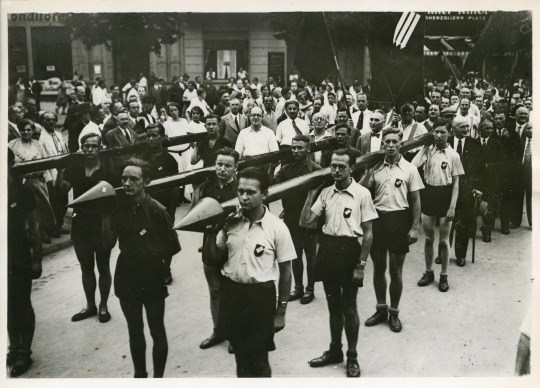#jungbanner
Photo

Aufmarsch der Eisernen Front zu einer Wahlkampfveranstaltung [Demonstration of the Iron Front at an election campaign event]
Keystone View Co.
Berlin, July 14, 1932
German Historical Museum, Berlin
Inventory no.: BA 95/1068
Der Dreipfeil, Drei Pfeile, or the Three Arrows was the symbol adopted by the Iron Front, organized by the Sozialdemokratische Partei Deutschlands and widely used from February 1932 on. In this photo it as carried by members of the SPD youth wing and the Reichsbanner’s ‘Jungbanner’ in a July 14 1932 rally during the federal election. As a symbol, it had multiple meanings: the three arrows embodied the SPD, trade unions and Reichsbanner Schwarz-Rot-Gold, the three main segments of the labor movement associated with the Iron Front, who represented the political, economic and physical aspects of social democracy. The Dreipfeil stood for “Aktivität, Disziplin und Einigkeit [activity, discipline and unity]” as well as for the "highest ideals" of the democratic socialists: Freiheit, Gleichheit, Brüderlichkeit [freedom, equality, fraternity.] It also stood for the struggle against the triple threat to the republic from National Socialism, Communism and Monarchism - ads often featured the three symbols of these groups struck out by the three arrows. Indeed, it had been adopted thanks to the inspiration of exiled Russian Sergei Tschachotin, who saw graffiti on a Nazi swastika in December 1931 and felt it symbolized working class resistance and would be easy to use to deface pro-Nazi graffiti, billboards, and posters.
Tschachotin and a Hessian SPD member of the Reichstag, Carlo Mierendorff, were also largely responsible for the reorientation of Social Democratic propaganda, and most of the symbolism and uses of the Three Arrows were due to them. They had recognized that the "age of the masses" required completely different forms of communication. In doing so, however, they had to overcome considerable resistance in the SPD bureaucracy. The dominance of the emotional over the rational, Tschachotin noted, had been fully grasped by the Nazi leaders, while the pro-republican SPD leaders still assumed that “the masses can be won over by pure conviction” and that loyalty to republican symbols and the Weimar constitution was sufficient. The Iron Front developed an extensive canon of symbols that was largely related to the three arrows, such as songs and the flag. This was red and showed the arrows in the lower left corner. Many SPD newspapers adopted the symbol at the top of their front page. According to Tschachotin and Mierendorff, it had to be “hammered into the readers a thousandfold, with and without a pierced swastika”. Countless songs and poems addressed the three arrows, and a book was published Dreipfeil gegen Hakenkreuz outling the meaning of the symbol and helping to launch the campaign. It was adopted at all levels by November 1932, just in time for the SPD’s crushing losses in that election, though of course it quickly took on a life of its own (and continues to be used) as a symbol of anti-fascism, shorn of the context of the final crisis of the Weimar Republic. Some information from here.
#sozialdemokratische partei deutschlands#der dreipfeil#three arrows#antifascism#eiserne front#iron front#reichstagswahl juli 1932#berlin#jungbanner#youth wing#paramilitary politics#spd#political rally#reichsbanner schwarz-rot-gold#political symbolism#political symbols#weimar republic#weimarer republik#crisis of the weimar republic
7 notes
·
View notes